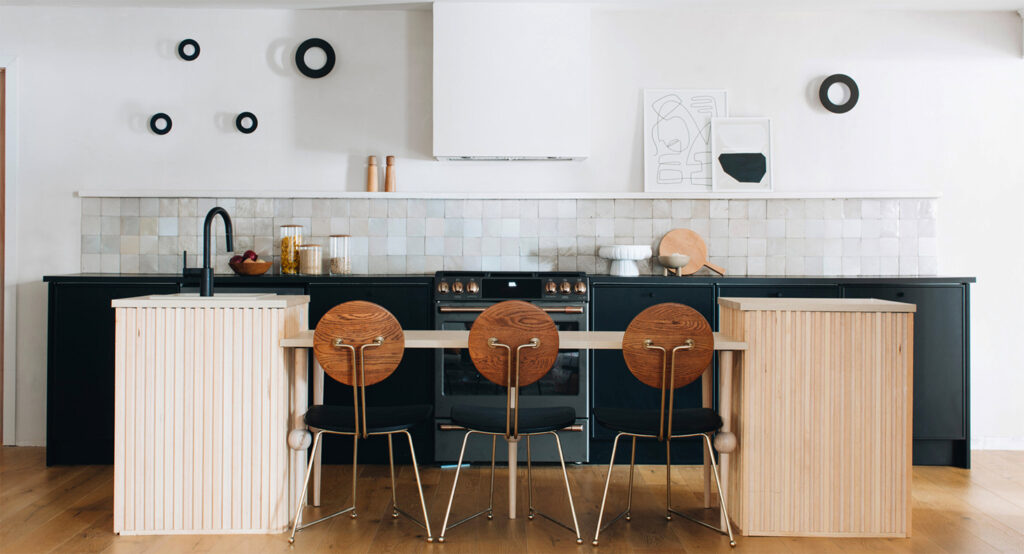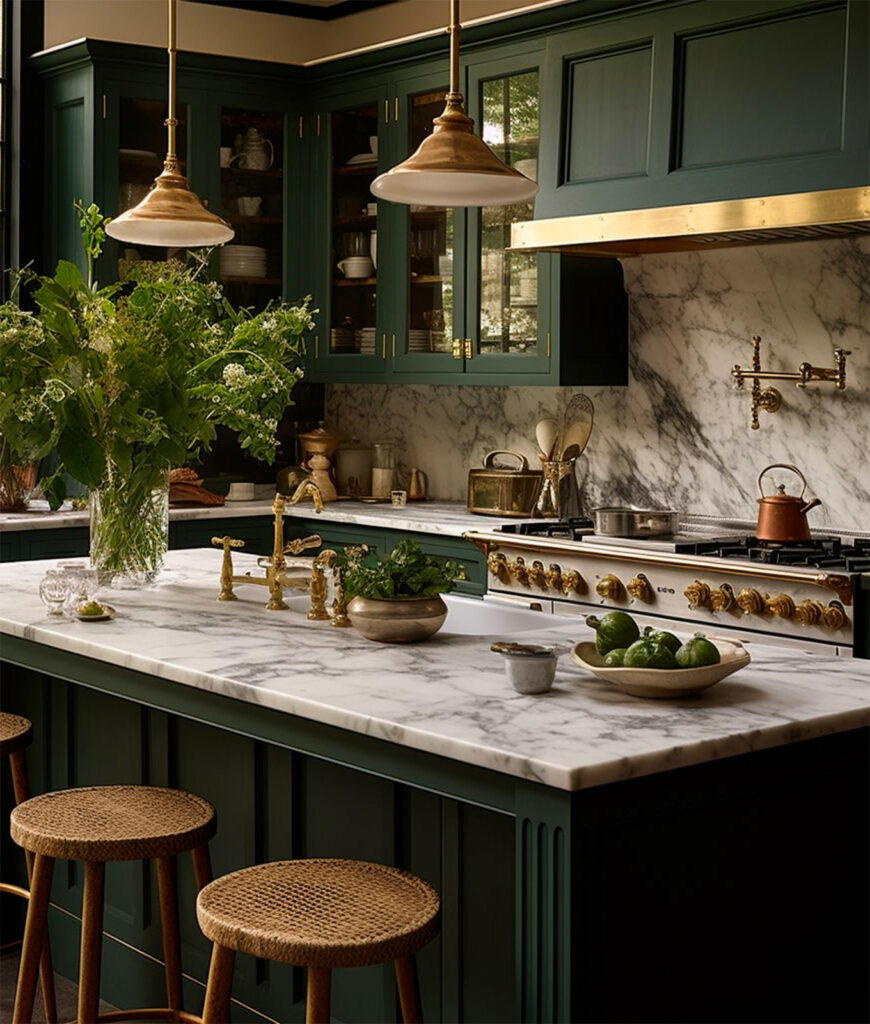The Designers Have Spoken: These Are the Top 10 Kitchen Trends of 2024


If the all-white kitchen you loved in 2012—or the Tuscan-inspired one you dreamed of in 2002—is making you want to tear out your cabinets, you’re not alone: Roughly 42 percent of people decided to renovate their kitchens in 2023, simply because they couldn’t stand their outdated style. It was the top reason cited for a remodel, according to Houzz’s 2023 U.S. Kitchen Trends Study, which polled 2,380 people on their renos—and design decisions. So, what trends have prevailed? And which looks are designers starting to see everywhere? Expect to see some big changes in color and texture, islands and appliances.
According to a 2024 report by The National Kitchen & Bath Association (NKBA), more than 600 industry experts agreed that clients are prioritizing “sociable, welcoming kitchens that encourage healthy habits with simple clean designs that connect to the outdoors.” To that end, you can expect to see some of big changes in color—green is predicted to be the most popular color choice for cabinets, walls and backsplashes—and nearly 60 percent of respondents said a dedicated beverage area within the kitchen will be in demand. So below, we did a deep dive to uncover the top kitchen trends of 2024, and (spoiler!) this year marks the return of minimalist lines and maximalist colors.
1. Fluted Wood
While we saw wooden cabinets—particularly white oak and walnut styles—take over in 2023, the look is being elevated this year with another exploding trend: fluted details. (ICYMI, flutes are those ribbed, textured lines that create an accordion-like effect through rows of vertically placed grooves—and we’re seeing them take over cabinets, backsplashes and islands in natural wood finishes.) Nearly one-fourth of designers agreed that fluted finishes would be big in the coming year, particularly with an emphasis on natural, high-texture wood. “As designs lean toward bringing the outside in, textures will also mimic nature, with more reeded styles for cabinetry,” the report mentions. “We’ve seen a very noticeable transition from white kitchens to white oak cabinetry. Pale white oak is the most popular, but darker tones are starting to crop up, and walnut has always been popular,” designer Sarah Robertson of Studio Dearborn says. “We are working to convince our clients to avoid white oak, which is a less sustainable option than other woods such as birch and alder, which are faster-growing trees.” Designer Jeanne Chung of Cozy·Stylish·Chic also speaks to this, adding: “Natural wood is a must in the kitchen to give warmth. Our clientele no longer wants a sterile kitchen—they want a kitchen with life that also feels lived in. White oak and walnut have been at the top of the list in terms of trending wood species, and we’re also starting to use alder, as it stains nicely, has a nice grain pattern, and it does well in both modern and traditional settings. It has a neutral tone and doesn’t feel as heavy and dated like some of the other wood species out there.”
2. Dedicated Beverage Areas
The most surprising trend to emerge from the report? Nearly 60 percent of respondents said a dedicated beverage area within the kitchen will be in demand. More specifically, 53 percent said clients are looking to incorporate a coffee center into the kitchen while 56 percent mentioned dedicated working areas for small appliances. “Beverage centers now include coffee/tea service, water dispensers, under-counter refrigeration and frozen goods storage for smoothies, shakes, and acai bowls, which have become a big part of what people commonly consume,” Elizabeth Valentina, CEO of Nar Design Group explains. Chung also mentions: “Our clients usually ask for a countertop espresso machine [if they don’t have the resources for] a built-in wall coffee unit [or] under-counter beverage unit. If there is room, there may be an additional column or glass front refrigerator to the side of the countertop area to store wine and additional beverages. The beverage/breakfast center is usually positioned away from the main prep area and in closer proximity to the breakfast table or seating area. Clients have asked to have a drawer or bin of grab-and-go snacks nearby, too.”
3. ‘Wrap-Around’ Islands
The island is the heart of the kitchen—and it makes sense that a whopping 78 percent of designers said this would be their number one priority in terms of build for 2024. “I have seen interesting developments in island design trending away from ‘all in a row’ island seating and towards ‘wrap-around’ seating, which has always been a favorite layout of mine,” says Robertson. In fact, about half of designers surveyed said clients are opening their floor plans to feature eat-in kitchens with a maximized island rather than closed-off, formal dining rooms. While 57 percent of respondents prefer an eat-in kitchen, about 20 percent identified the use of traditional stand-alone kitchen tables as an outgoing trend—making room for a multifunction island. “The island is a focal point and an opportunity to create a work of art by using a unique piece of stone, contrasting colors, or materials. It’s also equally important to think about designing the island to be multi-functional. I see it evolving into different shapes with the use of unique and textural cabinetry, like a fine furniture piece for your kitchen,” designer Julee Ireland adds.
4. Green Finishes
It may or may not come as a shock that, when asked about color trends for the kitchen, designers across the board cited green as their top answer. According to Ireland, “The color green is still going strong in design in general, from walls to cabinets to tile. I have traveled to Spain, Portugal, and Italy to the design and tile shows this year, and it’s shown in every collection as part of the color palette, which tells me it’s here to stay for a while. I personally love green in all shades for its ability to connect you with nature—from the deep saturated tones found in the rainforest to the soft, muted shades of green found by the sea. It’s a bolder choice, and you really have to have a client who is not afraid of color to make it work.” To that end, Vicky Serany, co-founder of Southern Studio adds: “The earthy comfort of green has been embraced by our clients recently. We have blended green cabinetry with natural wood and even creamy whites. For those clients who are a bit cautious of committing to green cabinetry, we’ve used a rich green backsplash with neutral painted cabinets with beautiful results.”
5. Layered Lighting
We’ve heard time and time again that layered interiors—or using multiple textures instead of single statement patterns—is the way to go. This school of thought seems to be making its way into lighting, where 85 percent of designers agreed ambient lighting in kitchens should be widely used to create different moods. What’s more, 80 percent said kitchens have become spaces for showcasing decorative, statement lighting: “The kitchen is the best room in the house to show multiple layers of lighting,” Chung explains. “We incorporate task lighting above work areas such as the island and sink area. Then we also add LED strip lighting to supplement the countertops around the perimeter of the room. Toe kick lighting, under-counter and in-cabinet lighting set the mood with warm, dimmable, ambient lighting. We love a tunable white where we can specify the color temperature. We strategically place smaller, targeted wall washers to illuminate the cabinetry, appliances, or even the art on the wall. The last layer is the accent lighting, which may include a picture light, decorative sconces, or even the light on the range knobs—the cool white light adds just a nice accent to call attention to the workhorse in the room.” Valentina also adds, “By turning off all the utilitarian aspects of overhead lighting, leaving just a gentle glow from chandeliers, toe kicks, art lights, or floating shelf lighting, we create the desired ambiance for the multitude of circumstances associated with modern living.”
6. Induction Cooktops
We hate to be the bearer of bad news but emissions from gas stove tops have been connected to an increased risk for childhood asthma—among other health concerns—per a pediatrician we consulted. Hence why it makes sense that 63 percent of designers said induction cooktops would be replacing gas ranges when asked which cooking appliances will be popular in kitchens over the next three years. This presumably has something to do with the fact that gas stovetops are being banned by multiple states for new construction builds. In 2019, Berkeley became the first CA city to ban natural gas hookups in new buildings. Since then, other hotspots, including the *entire state* of New York have followed suit, banning natural gas and fossil fuels in most new buildings. And of course, this also has to do with the impact fossil fuel emissions have on a warming planet (see below for more sustainable trends).
7. Bold Porcelain Backsplashes
While 71 percent of designers said backsplashes are becoming statement pieces—mainly through bold colors and unique patterns—61 percent cited ceramic/porcelain tile as the material of choice for 2024. Georgie Smith and Hilary Gibbs, co-founders of tile company LIVDEN, are seeing this uptick in bold, vibrant backsplash tile, particularly designs that feature organic shapes, like their Honeysuckle and Pebbles styles. For a budget-friendly update, the duo recommends using this type of tile on a smaller scale, having it extend just behind the range, rather than wrapping your whole kitchen walls in it. “This creates an impactful focal point,” they explained.
8. Built-In Organization
The kitchen isn’t just the heart of the home; it’s the hub. And as such, your phone should never run out of juice mid-recipe. While 90 percent (!!) of designers said homeowners want cabinets with better storage like drawer dividers and partitions that can be configured to their needs, they also mentioned the need for more drawers, charging stations and hidden electrical outlets. “Storage is more important than ever with so many customized options. The priorities typically include large, deep drawers, pantry cabinets, spice storage, trash and recycling centers, and open shelving,” Serany explains. Chung adds: “When customizing storage, we really take into consideration everything that the client owns—small appliances, the size of their pots and pans, how many spices they have and where they want them stored in relation to where they are cooking. Everything must have a home, and we customize the size/shape of each door and drawer and the hardware and inserts that go within to make sure we achieve that.”
9. Quiet Luxury Appliances
Another unanticipated trend to emerge from the report? 65 percent of designers said ‘ultra-quiet’ appliances will be all the rage this year. “When specifying a dishwasher, ultra-quiet is important, as the open-concept kitchen is usually near the family room, where the sound may fight with the TV. Multi-function capabilities, especially when in conjunction with specialty kitchen appliances, are a plus,” Chung explains. And in terms of aesthetics, people are still loving the integrated cabinetry look with 70 percent of respondents saying clients want appliances that can be paneled to match the surrounding cabinet faces. “Designers want the kitchen to flow and not feel so utilitarian,” says Kim Armstrong of Kim Armstrong Interior Design. As a result, “many items are getting integrated into the cabinetry, and cabinets are feeling less standardized, and not as ‘off the shelf’ as before.” Essentially, integrated cabinetry covers up appliances, giving everything a more streamlined, uniform look.
10. Sustainability
Sustainability is a trend that’s not going anywhere any time soon, which makes sense: If you’re spending all that money upgrading your kitchen, you might as well use materials that help lower your bills (and help the environment) in the long-term, right? While storage for recycling and energy efficient products were of the utmost importance when it came to the NKBA report, people also want sustainable features—like energy-efficient appliances and windows, more water-efficient fixtures and LED bulbs—in their homes (92 percent of those surveyed in Houzz’s 2023 report used ‘em, in fact). Ireland says, “There is always the consideration of energy efficiency and the carbon footprint. For some of my clients, these elements matter and for others, they just want what they want. At the end of the day, it’s our job as designers to really understand our client’s lifestyle and desires so we can help navigate them towards decisions that achieve their dream home.”
By Sydney Meister Additional reporting by Candace Davison Published Jan 26, 2024
DESIGN YOUR FUTURE TODAY!
Interior Designers Institute was founded in 1984 and is one of the few Interior Design Schools in California offering an Avocational Certificate Course, Associate of Arts Degree in Interior Design, Bachelor of Arts Degree in Interior Design, and Master of Interior Architecture Degree and is nationally accredited and also accredited by CIDA, Council for Interior Design Accreditation.











